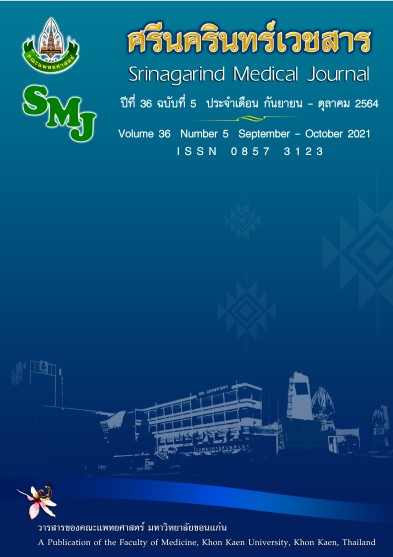Validity of Pre-Operative and Post-Operative Cardiac Rehabilitation Questionnaires in Patients with Open Heart Surgery
Keywords:
Pre-operative program; Cardiac rehabilitation; Open heart surgery; QuestionnaireAbstract
Background and Objectives: Patients who plan for open heart surgery should gain knowledge about pre-operative and post-operative cardiac rehabilitation for their rapid recovery and safety. Presently, there is no valid tool for determining patients’ knowledge and comprehension in pre-operative and post-operative cardiac rehabilitation. Thus, we developed questionnaires for determining knowledge and comprehension in the pre-operative and post-operative cardiac rehabilitation for patients with open heart surgery.
Methods: This study design was a cross-sectional descriptive study. The questionnaires were consisted of 10 pre-operative and 8 post-operative cardiac rehabilitation items. The questionnaires’s validity was assessed by 36 medical personnels (physiotherapists, physicians, and nurses) who worked at Queen Sirikit Heart Center of the Northeast and physiotherapists who worked at nearby hospitals. The Index of item-objective congruence (IOC) > 0.8 was considered as valid.
Results: The IOC score of all items in the pre-operative and post-operative cardiac rehabilitation questionnaires was > 0.8, except post-operative rehabilitation item 4 which IOC was 0.5. The IOC of item 4 after adjusting was > 0.8.
Conclusions: Questionnaires for determining knowledge and comprehension in pre-operative and post-operative cardiac rehabilitation for patients with open heart surgery were valid.
References
2. Salim SV, Alvaro A, Emelia JB, Marcio SB, Clifton WC, April PC, et al. Heart disease and stroke statistics 2020 update: a report from the American Heart Association Statistics Committee and Stroke Statistics Subcommittee. Circulation 2020; 119: 139-596.
3. สมาคมศัลยแพทย์ทรวงอกแห่งประเทศไทย. สถิติการผ่าตัดหัวใจ [อินเทอร์เน็ต]. 2562 [เข้าถึงเมื่อ 20 กรกฎาคม 2563] เข้าถึงได้จาก http://thaists.org/news_detail.php?news_id=212
4. Rosdahl CB, Kowalski MT. Textbook of basic nursing. 9th ed. New York:Lippincott Williams & Wilkins; 2008.
5. ฐิติกัญญา ดวงรัตน์. Critical care in cardiothoracic surgery: sedation and analgesia in cardiothoracic surgery. ใน: เกรียงชัย ประสงค์สุกาญจน์, วีระชัย นาวารวงศ์, บรรณาธิการ. Critical care in cardiothoracic surgery. พิมพ์ครั้งที่ 1. กรุงเทพมหานคร:บียอนด์ เอ็นเทอร์ไพรซ์; 2552: 59-71.
6. Adams J, Lotshaw A, Exum E, Campbell M, Spranger CB, Beveridge J, et al. An alternative approach to prescribing sternal precautions after median sternotomy, “Keep Your Move in the Tube”. Proc (Bayl Univ Med Cent) 2016; 29(1): 97–100.
7. Katijjahbe MA, Granger CL, Denehy L, Royse A, Royse C, Bates R, et al. Standard restrictive sternal precautions and modified sternal precautions had similar effects in people after cardiac surgery via median sternotomy (‘SMART’ Trial): a randomised trial. J Physiother 2018; 64(2): 97–106.
8. Clini E, Ambrosino N. Early physiotherapy in the respiratory intensive care unit. Resp Med 2005; 99(9): 1096-1104.
9. Ambrosino N, Venturelli E, Vagheggini G, Clini E. Rehabilitation, weaning and physical therapy strategies in chronic critically ill patients. Eur Respir J 2012; 39: 487–492.
10. American Association of Cardiovascular & Pulmonary Rehabilitation. Guidelines for cardiac rehabilitation and secondary prevention programs. 6th ed. Illinois:Human Kinetics; 2020.
11. American Association of Cardiovascular & Pulmonary Rehabilitation. Guidelines for cardiac rehabilitation and secondary prevention programs. 4th ed. Illinois:Human Kinetics; 2004.
12. Westerdahl E, Lindmark B, Eriksson T, Hedenstierna G, Tenling A. Deep-breathing exercises reduce atelectasis and improve pulmonary function after coronary artery bypass surgery. Chest 2005; 128(5): 3482-3488.
13. Yánez-Brage I, Pita-Fernández S, Juffé-Stein A, Martínez-González U, Pértega-Díaz S, Mauleón-García Á. Respiratory physiotherapy and incidence of pulmonary complications in off-pump coronary artery bypass graft surgery: an observational follow-up study. BMC pulmonary medicine 2009; 9(36): 1-10.
14. ชมรมฟื้นฟูหัวใจ. แนวทางการฟื้นฟูสภาพในผู้ป่วยโรคหัวใจ (Cardiac Rehabilitation Guideline) [อินเทอร์เน็ต]. 2562. [เข้าถึงเมื่อ 30 กรกฎาคม 2563] เข้าถึงได้จาก http://www.thaiheart.org/images/column_1291454908/RehabGuideline.pdf
15. George AJ, Gordon PB. Initial Scale Development: Sample Size for Pilot Studies. Educ Psychol Meas 2009; 70; 394-400.
16. สุรพงษ์ คงสัตย์, ธีรชาติ ธรรมวงค์. การหาค่าความเที่ยงตรงของแบบสอบถาม (IOC)[อินเตอร์เน็ต]. 2558 [เข้าถึงเมื่อ 30 กรกฎาคม 2563]. เข้าถึงได้จาก https://www.mcu.ac.th/article/detail/14329.



